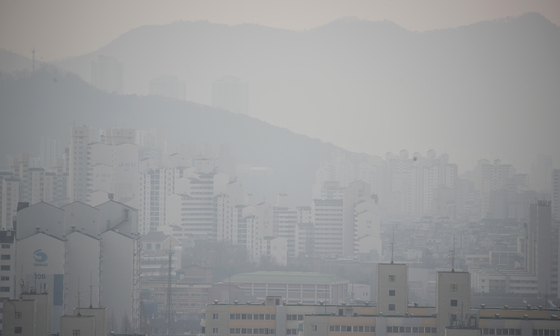
On the 14th when the ultrafine dust advisory was issued, the city center viewed from an apartment in Nowon-gu, Seoul was cloudy. News 1
The high concentration of fine dust, which continued throughout the Lunar New Year holiday, continues to rise nationwide even on the 14th, the last day of the holiday. Accordingly, emergency measures to reduce fine dust were implemented in Seoul and other metropolitan areas for the first time this year.
According to Air Korea, Korea Environment Corporation on the 14th, the concentration of ultrafine dust (PM2.5) in Seoul as of 11 o’clock on the 14th was 57㎍ per ㎥ (microgram, 1㎍ = 1 in 1 million), which was’bad (36~75). ㎍/㎥)’ level is recorded. In the case of Jung-gu, Seoul, the concentration of ultra-fine dust soared to 83㎍/㎥ at 8 am, to the level of’very bad (76㎍/㎥~)’.
Gyeonggi-do’s 74㎍/㎥ showed a concentration that was close to the’very bad’ standard, while Chungnam’s 89㎍/㎥ exceeded the’very bad’ standard. Most of the rest of the regions also record ultrafine dust concentrations that exceed the’bad’ level.
The National Institute of Environmental Sciences Air Quality Integrated Forecast Center said, “On the 14th, fine dust remains in most regions the day before, and the concentration is expected to be high as fine dust generated in Korea due to atmospheric congestion is added.”
In Seoul, from the 11th, the first day of the Lunar New Year holiday, the daily average concentration of ultrafine dust has recorded a level of’bad’. This is the first time in this winter that high concentration of fine dust has continued for four consecutive days.
An official from the Air Quality Integrated Forecast Center of the National Institute of Environmental Sciences said, “During the holiday season, the high pressure on the Korean peninsula has established a stable atmospheric condition, so fine dust introduced from abroad and pollutants generated in Korea cannot escape to the upper atmosphere or the sea. The high concentration situation continued for a long time,” he explained.
First emergency reduction measures this winter… Stop coal power

On the morning of the 14th, in Sejong-ro, Jung-gu, Seoul, Jung-gu officials are cleaning to reduce fine dust with a water cleaning car and a dust suction car. yunhap news
As high-density fine dust continues throughout the holiday, the Ministry of Environment issued an ultra-fine dust (PM2.5) crisis warning’interest’ stage in Seoul, Incheon, Gyeonggi and other metropolitan areas, Sejong, Chungcheong, and other areas, and from 6 am to 9 pm Emergency fine dust reduction measures were implemented. This is the first time that emergency measures to reduce fine dust have been implemented in the metropolitan area this year. Emergency reduction measures are issued when a situation where the concentration of fine dust exceeds a certain level is predicted to continue.
As a result, reinforced measures to reduce fine dust emissions, such as adjustment of operation rates and operating hours, have been implemented at mandatory workplaces and construction sites in the metropolitan and Chungcheong areas. In addition, 14 coal generators were shut down, and an upper limit (80% power limitation) was applied for 44 units. However, due to the fact that vehicles are not operated on holidays and are not concentrated at specific times, it has been decided not to restrict the operation of old cars (class 5 cars).
Environment Minister Han Jeong-ae said, “I hope that the people will refrain from outside activities for health purposes until the end of the Lunar New Year holiday and observe the People’s Participating Travel Building, such as wearing masks.”
“Relieving fine dust from daytime on the 15th”
Even on the 15th, the whole country will be hazy due to the high concentration of fine dust. In southern Gyeonggi Province, Sejong, Chungbuk and Daegu, the concentration of ultrafine dust is expected to record’bad’ levels. In the rest of the metropolitan area, such as Seoul, Incheon, and northern Gyeonggi, the concentration of ultrafine dust in Gangwon-do, Yeongseo and Chungnam will rise to’bad’ in the morning.
The high concentration of fine dust is expected to be gradually resolved from the afternoon of the 15th. An official from the Air Quality Integrated Forecast Center of the National Institute of Environmental Sciences said, “From tomorrow, the concentration of fine dust is expected to gradually decrease as the wind becomes stronger and the air spreads smoothly.” “In Seoul, the concentration of fine dust is expected to be normal between late afternoon and night. It looks like it will recover.”
Reporter Chun Kwon-pil [email protected]
